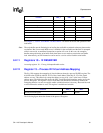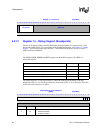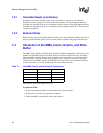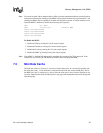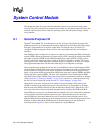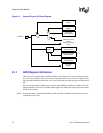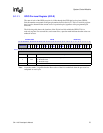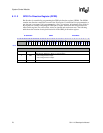
SA-1110 Developer’s Manual 69
Clocks 8
This section describes the Intel
®
StrongARM
*
SA-1110 Microprocessor (SA-1110) clocks. The
following diagram shows the distribution of clocks in the SA-1110. The 3.6864-MHz oscillator
feeds both PLLs. The primary PLL provides clocks for the core logic and a 7.36-MHz clock for
several of the serial controllers. The core, Dcaches, and read and write buffers use either the
full-speed core clock or the divided-down clock. The LCD controller, DMA, memory controller,
and GPIO use the core clock divided by 2 (RCLK). The 32.768-kHz oscillator feeds the real-time
clock (RTC) and the power manager logic. The secondary PLL provides the clock for the UDC, the
ICP, and the MCP. The oscillators and PLLs are completely integrated with the SA-1110 and
require no external devices other than the crystals for operation.The following figure shows a block
diagram of the clocking system for the SA-1110.
Figure 8-1. SA-1110 Clock System Block Diagram
8.1 Intel
®
StrongARM SA-1110 Crystal Oscillators
The SA-1110 clocks are derived from two crystals connected to on–chip oscillators. The first clock
source is a 3.6864-MHz crystal that feeds the CPU PLL and the 48-MHz PLL. The CPU PLL
multiplies the oscillator output up to the core frequency. This frequency is then divided down to
generate baud rates for the serial ports. If the UARTs are not being used or do not need standard
A8054-01
32.768 kHz
Oscillator
Primary PLL
59 MHz - 200 MHz
Secondary PLL
48 MHz
GPIO 27
Peripherals
UART: 7.36 MHz
ICP: 7.36 or 48 MHz
MCP/SSP: 7.36 or 12 MHz
PPC: 7.36 MHz
UDC: 48 MHz
3.6864 MHz
Oscillator
Divide
by 2
Intel
®
ARM*
SA-1 Core
LCD
Controller
RTC and Power
Manager
DMA
Controller
Memory
Controller
I/O
Controller
Write Buffer
I-Cache
D-Cache
Read Buffer



